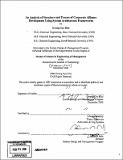An analysis of structure and process of corporate alliance development using system architecture frameworks
Author(s)
Kim, Gwang Gyu
DownloadFull printable version (4.827Mb)
Other Contributors
System Design and Management Program.
Advisor
Edward Crawley.
Terms of use
Metadata
Show full item recordAbstract
A strategic alliance has been one of the core methods for expanding the business of many corporations in terms of geographic presence, business domain, and technological scope. The strategic alliance includes many different types of partnerships, including licensing in and out, joint product development, minority equity investments, joint ventures, and mergers and acquisitions. These alliances involve many distinctive participants inside and outside a corporation and for this reason, the alliance-forging process and management tend to be quite complicated for systematic analysis. Therefore in this thesis I employ system architecture frameworks to analyze strategic alliances in a systematic way from a holistic viewpoint. I apply an object process methodology (OPM) to understand interactions among different participants during the process of forging alliances, analyze the upstream and downstream influences, and finally adopt a holistic framework to illustrate detailed interactions during the process. The alliance process basically consists of four distinctive phases: formulation, partner selection, negotiation, and management. Comparing the results with the DuPont case, I realized that the alliance management phase should be augmented for more comprehensive management. Strategic alliances and mergers and acquisitions are discussed in the corporate-level context. They have many driving forces in common at the level of corporate context, but in mergers and acquisitions the economic conditions are more critical components than others during a strategy- formulation phase.
Description
Thesis (S.M.)--Massachusetts Institute of Technology, System Design and Management Program, February 2007. Includes bibliographical references (leaves 95-97).
Date issued
2007Department
System Design and Management Program.Publisher
Massachusetts Institute of Technology
Keywords
System Design and Management Program.